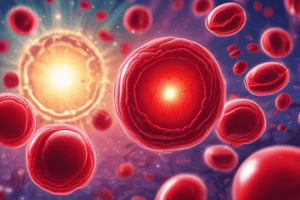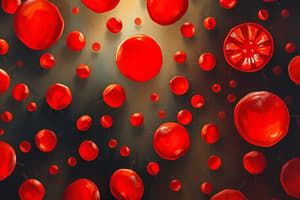Podcast
Questions and Answers
What triggers compensatory erythropoiesis?
What triggers compensatory erythropoiesis?
- Increased levels of conjugated bilirubin
- Increased destruction of red blood cells (correct)
- Increased oxygen levels in the blood
- Decreased vitamin B12 levels
Elevated levels of unconjugated bilirubin can lead to jaundice.
Elevated levels of unconjugated bilirubin can lead to jaundice.
True (A)
What is the normal range of reticulocytes in the blood?
What is the normal range of reticulocytes in the blood?
0.5% to 2.5%
The __________ test detects antibodies attached to red blood cells.
The __________ test detects antibodies attached to red blood cells.
Match the following diagnostic tests with their purposes:
Match the following diagnostic tests with their purposes:
What can cause hemolytic anemia?
What can cause hemolytic anemia?
Symptoms of hemolytic anemia include fatigue, jaundice, and increased energy levels.
Symptoms of hemolytic anemia include fatigue, jaundice, and increased energy levels.
What is the lifespan of a normal red blood cell?
What is the lifespan of a normal red blood cell?
In hemolytic anemia, the destruction of red blood cells leads to the release of ______ into the bloodstream.
In hemolytic anemia, the destruction of red blood cells leads to the release of ______ into the bloodstream.
Match the treatment options for hemolytic anemia with their purposes:
Match the treatment options for hemolytic anemia with their purposes:
Flashcards are hidden until you start studying
Study Notes
Hemolytic Anemia
- Occurs when RBCs are destroyed faster than they can be produced.
- Can be inherited (e.g., sickle cell anemia, thalassemia, G6PD deficiency) or acquired (e.g., autoimmune disorders, infections, medications, toxins).
- Destruction can be intrinsic (due to defects within RBCs) or extrinsic (due to external factors).
Symptoms of Hemolytic Anemia
- Fatigue
- Pallor (pale skin)
- Jaundice (yellowing of the skin and eyes)
- Shortness of breath
Treatment Options for Hemolytic Anemia
- Blood Transfusions: Used for patients with severe forms of thalassemia to prevent complications like delayed growth, heart failure, and bone deformities.
- Iron Chelation Therapy: Used to manage iron overload caused by regular transfusions, which can damage the heart, liver, and endocrine organs.
- Folic Acid Supplementation: Helps in the production of red blood cells and supports mild cases of thalassemia.
Biochemistry Pathway of Hemolytic Anemia
- Premature destruction of RBCs, leading to the release of hemoglobin into the bloodstream.
- Hemoglobin dissociates into heme and globin.
- Heme is degraded, forming biliverdin, which is then reduced to unconjugated bilirubin.
- Unconjugated bilirubin is transported to the liver and conjugated.
- Conjugated bilirubin is excreted into bile and subsequently into the intestines.
- Increased destruction of RBCs triggers the bone marrow to enhance erythropoiesis, resulting in the release of more reticulocytes into the bloodstream.
Diagnosis of Hemolytic Anemia
- Peripheral Blood Smear (PBS) Test: Examines red blood cells, white blood cells, and platelets under a microscope.
- Complete Blood Count (CBC): Measures different components of blood, including RBC count, hemoglobin, and hematocrit.
- Reticulocyte Test: Measures the number of reticulocytes, which are immature red blood cells. It helps assess bone marrow function and red blood cell production. The normal range is approximately 0.5% to 2.5% of total red blood cells.
- Direct Coombs Test: Detects antibodies attached to red blood cells, indicating immune-mediated hemolytic anemia.
- Urinalysis: Checks for hemoglobinuria (hemoglobin in the urine) and hemosiderin.
Studying That Suits You
Use AI to generate personalized quizzes and flashcards to suit your learning preferences.




